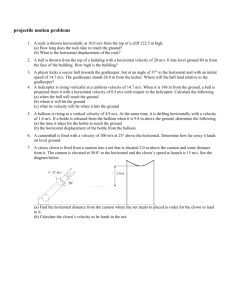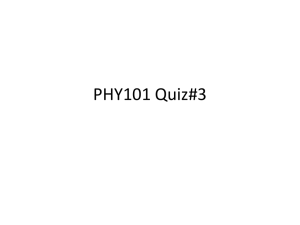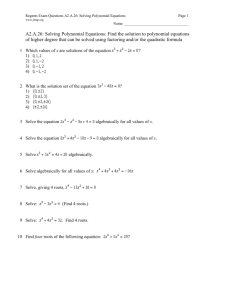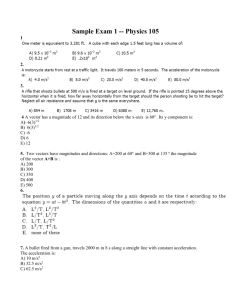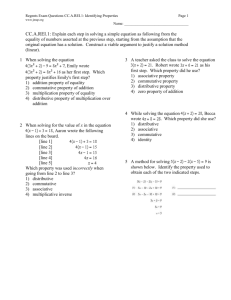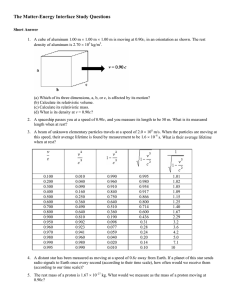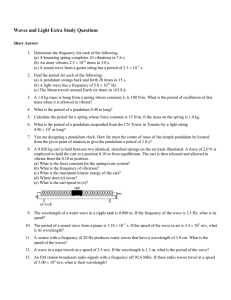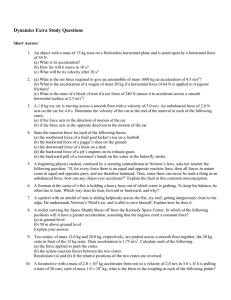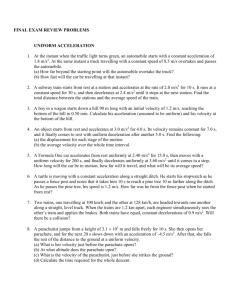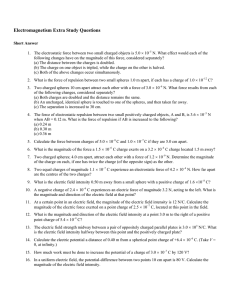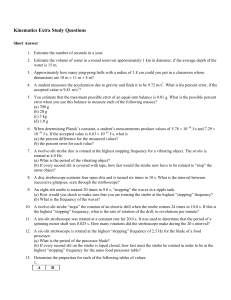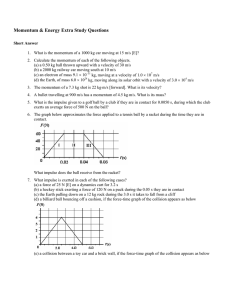Exam Review - HRSBSTAFF Home Page
advertisement
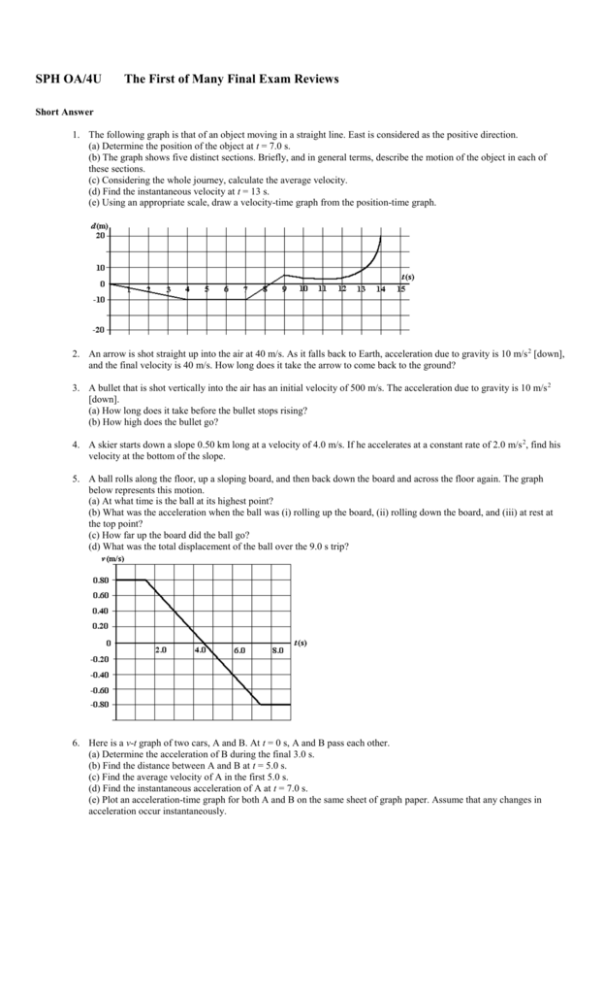
SPH OA/4U The First of Many Final Exam Reviews Short Answer 1. The following graph is that of an object moving in a straight line. East is considered as the positive direction. (a) Determine the position of the object at t = 7.0 s. (b) The graph shows five distinct sections. Briefly, and in general terms, describe the motion of the object in each of these sections. (c) Considering the whole journey, calculate the average velocity. (d) Find the instantaneous velocity at t = 13 s. (e) Using an appropriate scale, draw a velocity-time graph from the position-time graph. 2. An arrow is shot straight up into the air at 40 m/s. As it falls back to Earth, acceleration due to gravity is 10 m/s 2 [down], and the final velocity is 40 m/s. How long does it take the arrow to come back to the ground? 3. A bullet that is shot vertically into the air has an initial velocity of 500 m/s. The acceleration due to gravity is 10 m/s 2 [down]. (a) How long does it take before the bullet stops rising? (b) How high does the bullet go? 4. A skier starts down a slope 0.50 km long at a velocity of 4.0 m/s. If he accelerates at a constant rate of 2.0 m/s 2, find his velocity at the bottom of the slope. 5. A ball rolls along the floor, up a sloping board, and then back down the board and across the floor again. The graph below represents this motion. (a) At what time is the ball at its highest point? (b) What was the acceleration when the ball was (i) rolling up the board, (ii) rolling down the board, and (iii) at rest at the top point? (c) How far up the board did the ball go? (d) What was the total displacement of the ball over the 9.0 s trip? 6. Here is a v-t graph of two cars, A and B. At t = 0 s, A and B pass each other. (a) Determine the acceleration of B during the final 3.0 s. (b) Find the distance between A and B at t = 5.0 s. (c) Find the average velocity of A in the first 5.0 s. (d) Find the instantaneous acceleration of A at t = 7.0 s. (e) Plot an acceleration-time graph for both A and B on the same sheet of graph paper. Assume that any changes in acceleration occur instantaneously. 7. A meson, a subatomic particle having a mass 250 times that of an electron, is shot with a constant speed of 5.00 106 m/s into a region where an electric field causes a deceleration of 1.25 1014 m/ s2. (a) How far does the meson travel before coming to rest? (b) How long does it take the meson to come to rest? 8. A car travels at 20 m/s [N35°E] for 3.0 s. Draw its velocity vector, and then, using scalar multiplication, draw the vector representing its displacement during this time interval. 9. A man drags a package across the floor with a force of a 40 N, as shown. The mass of the package is 10 kg. If the acceleration of the package is 3.5 m/s2, and friction can be neglected, at what angle to the horizontal does the man pull? 10. A rock is thrown horizontally at 10.0 m/s from the top of a cliff 122.5 mm high. (a) How long does the rock take to reach the ground? (b) What is the horizontal displacement of the rock? 11. Calculate the gravitational attraction between a proton of mass 1.67 10–27 kg and an electron of mass 9.11 10–31 kg if they are 5 10–11 m apart (as they are in a normal hydrogen atom). 12. Find the acceleration of a falling object on Mars, given that the radius of Mars is one-half that of Earth and the mass of Mars is one-eighth that of Earth. 13. A spring whose force constant is 48 N/m has a 0.25 kg mass suspended from it. What is the extension of the spring? 14. From inside an aquarium, a ray of light is directed at the glass so that the angle of incidence, in water, is 30°. (a) Determine the angle of refraction when the ray emerges from glass into the air. (b) If the angle of incidence in the water is 52°, at what angle will the rays emerge from the glass? 15. The tine of a tuning fork vibrates with an amplitude of 0.13 cm. If the frequency of the fork is 200 Hz, what total distance will the tine travel in 1.00 min? Problem 16. A convertible with its top down drove towards the entrance of an underground garage with a velocity of 24 km/h. A window cleaner on a scaffold directly above the entrance accidentally kicked a bucket of water off a moving scaffold. The scaffold at that moment was 9.0 m vertically higher than the top of the car and the car was 12 m from the entrance. The scaffold was moving up at 1.5 m/s. Did the driver get wet? 17. A slightly disoriented homing pigeon flies the following course at a constant speed of 15 m/s: (i) 800 m, 37° east of north, (ii) 300 m due west, and (iii) 400 m, 37° south of east A crow flies in a straight line (as the crow flies) between the starting and finishing points. At what speed must the crow fly if the birds leave and arrive together? 18. A canoeist paddles “north” across a river at 3.0 m/s. (The canoe is always kept pointed at right angles to the river.) The river is flowing east at 4.0 m/s and is 100 m wide. (a) What is the velocity of the canoe relative to the river bank? (b) Calculate the time required to cross the river. (c) How far downstream is the landing point from the starting point? 19. A 5.0 kg mass rests on a level, frictionless table, attached to a 3.0 kg mass by a light string that passes over a frictionless pulley. Calculate the tension in the string when the masses are released. 20. A fish hangs from a spring scale supported from the roof of an elevator. (a) If the elevator has an upward acceleration of 1.2 m/s2 and the scale reads 200 N, what is the true force of gravity on the fish? (b) Under what circumstances will the scale read 150 N? (c) What will the scale read if the elevator cable breaks? 21. A satellite circles Earth at an average altitude of 760 km, with a period of 100 min. Calculate the mass of Earth. 22. A 1.0 kg cart moving at 2.5 m/s collides head-on with a 4.0 kg cart moving in the same direction at 0.50 m/s. The F-x graph for the collision is shown. The total kinetic energy at minimum separation is 2.0 J. What is the minimum separation of the two trolleys during the collision? 23. A truck of mass 3000 kg, moving at 5.0 m/s on a level, icy road, bumps into the rear of a car moving at 2.0 m/s in the same direction. After the impact the truck has a velocity of 3.0 m/s and the car a velocity of 6.0 m/s, both forward. (a) What is the mass of the car? (b) Calculate the total kinetic energy before and after the collision. (c) Was the collision elastic? 24. A spherical, polished metallic ball is used as a diverging mirror (f = –20 cm) over a bird bath. A bird, 25 cm tall, standing 50 cm away, looks directly at the mirror. What are the size and position of the bird’s image? 25. A projector is required to make a real image, 0.5 m tall, of a 5.0 cm object placed on a slide. Within the projector, the object is to be placed 10.0 cm from the lens. What must be the focal length of the lens? SPH OA/4U First of Many FInal Exam Reviews Answer Section SHORT ANSWER 1. ANS: (a) Position after 7.0 s is –10 m or 10 m [W]. (b) (i) t = 0 to t = 4.0 s Uniform velocity of 2.5 m/s [W]. (ii) t = 0 to t = 7.0 s – stopped. (iii) t = 7.0 s to t = 9.0 s Uniform velocity of 7.5 m/s [E]. (iv) t = 7.0 s to t = 11.0 s Uniform velocity of approximately 1.3 m/s [W]. (v) t = 11.0 s to t = 14.0 s Uniform acceleration in the easterly direction. (c) (d) (e) REF: MSC: K/U P OBJ: 1.1 LOC: FM1.02 KEY: FOP 2.6, p.56 K/U P OBJ: 1.3 LOC: FM1.02 KEY: FOP 2.9, p.65 2. ANS: REF: MSC: 3. ANS: Choosing up as positive and down as negative, v1 = 500 m/s ag = –10 m/s2 v2 = 0 (a) (b) Solution 1: Solution 2: REF: MSC: K/U SP OBJ: 1.3 LOC: FM1.02 KEY: FOP 2.13, p.72 K/U P OBJ: 1.2 LOC: FM1.02 KEY: FOP 2.13, p.73 4. ANS: REF: MSC: 5. ANS: (a) 4.5 s (b) (c) (d) Sum of areas = 0, thus the total displacement is zero REF: MSC: K/U P OBJ: 6. ANS: (a) (b) The distance between A and B is (c) (d) (e) 1.2 LOC: FM1.02 KEY: FOP 2.15, p.81 REF: MSC: K/U, C P OBJ: 1.2 LOC: FM1.02 KEY: FOP 2.15, p.83 K/U P OBJ: 1.2 LOC: FM1.02 KEY: FOP 2.15, p.85 OBJ: 1.1 LOC: FMV.01 KEY: FOP 3.5, p.98 7. ANS: (a) (b) REF: MSC: 8. ANS: 1 cm = 5 m/s REF: MSC: K/U P 9. ANS: If the angle of the between the rope and horizontal is , the net horizontal force on the package is: But REF: MSC: K/U P OBJ: 2.2 LOC: FMV.01 KEY: FOP 4.8, p.153 10. ANS: (a) The time required for the projected rock to reach the ground is equal to the time it would take it to fall straight down. The time required to fall vertically is determined as follows. Assume that up is positive and down is negative. (b) The motion in the horizontal direction is uniform. Thus, REF: MSC: K/U SP OBJ: 1.4 LOC: FM1.03 KEY: FOP 5.8, p.172 K/U P OBJ: 3.3 LOC: FM1.06 KEY: FOP 7.9, p.287 11. ANS: REF: MSC: 12. ANS: REF: MSC: K/U P OBJ: 3.3 LOC: FM1.06 KEY: FOP 7.9, p.288 4.5 LOC: EM1.08 KEY: FOP 10.1, p.374 13. ANS: If the spring obeys Hooke’s Law, REF: MSC: K/U SP OBJ: 14. ANS: (a) (b) The ray will not emerge. = 49° is the limit—the same as it is when a ray travels from water to air. REF: MSC: K/U P OBJ: 9.1 LOC: WA1.01 KEY: FOP 11.12, p.442 15. ANS: Distance travelled in one second is: Distance travelled in one minute is: REF: PROBLEM 16. ANS: K/U KEY: FOP 12.10, p.478 MSC: P Time for the convertible to reach the scaffold: Time for pail to fall: The negative answer has no meaning in this question. Since the pail only requires 1.5 s to reach the ground and the car requires 4.5 s to reach the scaffold, the driver does not get wet. REF: MSC: K/U P OBJ: 1.3 LOC: FM1.02 17. ANS: Using components in the x and y directions, for the homing pigeon KEY: FOP 2.15, p.87 Time for homing pigeon REF: MSC: K/U P OBJ: 1.1 18. ANS: (a) (b) The canoe crosses the river at (c) The canoe “moves downstream” at LOC: FM1.02 KEY: FOP 3.11, p.126 REF: MSC: K/U P OBJ: 1.5 LOC: FM1.02 KEY: FOP 3.7, p.109 K/U P OBJ: 2.3 LOC: FMV.02 KEY: FOP 5.3, p.161 19. ANS: REF: MSC: 20. ANS: (a) (b) (c) If the cable breaks, there is no force on the object by the scale. REF: MSC: K/U P OBJ: 2.3 LOC: FMV.02 KEY: FOP 5.13, p.198 21. ANS: The force of gravitational attraction provides the centripetal factor necessary to hold the satellite in orbit around Earth. Thus, there are two expressions for this force: But or REF: MSC: K/U, MC SP OBJ: 3.4 22. ANS: Before the collision: If Ek(total) at minimum separation is 2.0 J, then LOC: FM1.06 KEY: FOP 7.8, p.284 REF: MSC: K/U P OBJ: 5.3 LOC: EM1.03 KEY: FOP 9.5, p.352 23. ANS: (a) For such a collision, (b) (c) Since REF: MSC: 24. ANS: K/U P the collision is elastic. OBJ: 5.3 LOC: EM1.05 KEY: FOP 9.9, p.370 The image is erect, 7.2 cm tall, virtual, and located 14.3 cm behind the surface of the polished ball. REF: K/U KEY: FOP 11.12, p.441 MSC: P 25. ANS: Note that REF: K/U . This is why slides must go in the projector upside down and backward. KEY: FOP 11.12, p.444 MSC: P
